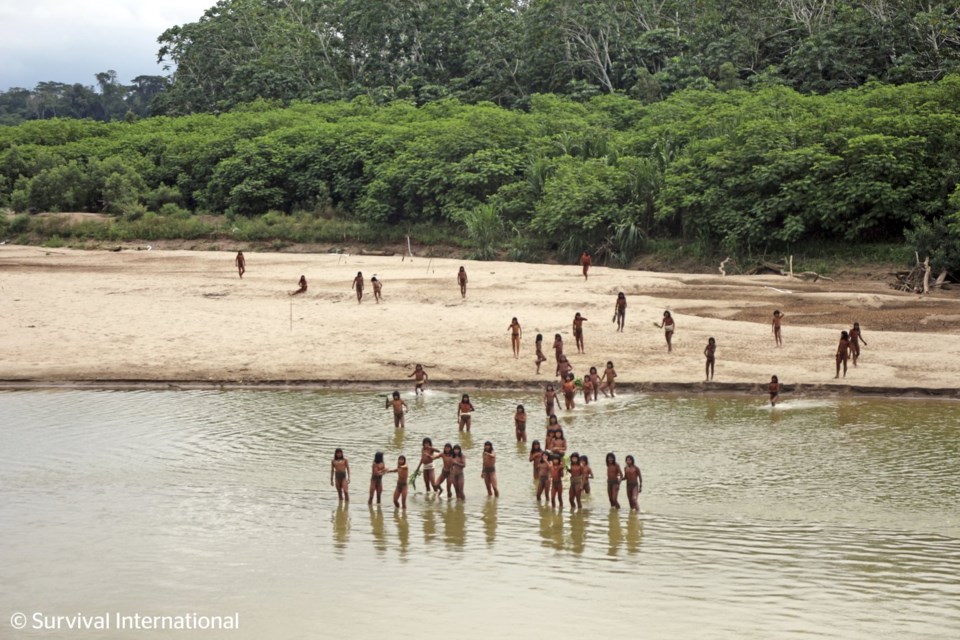An advocacy group for Indigenous peoples has released photographs of a reclusive tribe's members searching for food on a beach in the Peruvian Amazon, calling it evidence that logging concessions are “dangerously close” to the tribe's territory.
Survival International said the photos and video it posted this week show members of the Mashco Piro looking for plantains and cassava near the community of Monte Salvado, on the Las Piedras River in Madre de Dios province.
Several logging companies hold timber concessions inside territory inhabited by the tribe, according to Survival International, which has long sought to protect what it says is the largest “uncontacted” tribe in the world. The proximity raises fears of conflict between logging workers and tribal members, as well as the possibility that loggers could bring dangerous disease to the Mashco Piro, the advocacy group said.
Two loggers were shot with arrows while fishing in 2022, one fatally, in a reported encounter with tribal members.
Cesar Ipenza, a lawyer who specializes in environmental law in Peru and is not affiliated with the advocacy group, said the new images “show us a very alarming and also worrying situation because we do not know exactly what is the reason for their departure (from the rainforest) to the beaches.”
Isolated Indigenous tribes may migrate in August to collect turtle eggs to eat, he said.
“But we also see with great concern that some illegal activity may be taking place in the areas where they live and lead them to leave and be under pressure,” he said. "We cannot deny the presence of a logging concession kilometers away from where they live.”
Survival International called for the Forest Stewardship Council, a group that verifies sustainable forestry, to revoke its certification of the timber operations of one of those companies, Peru-based Canales Tahuamanu. The FSC responded in a statement Wednesday that it would “conduct a comprehensive review” of the company's operations to ensure it's protecting the rights of Indigenous peoples.
Canales Tahuamanu, also known as Catahua, has said in the past that it is operating with official authorizations. The company did not immediately respond to a message Thursday seeking comment on its operations and the tribe.
A 2023 report by the United Nations' special reporter on the rights of Indigenous peoples said Peru's government had recognized in 2016 that the Mashco Piro and other isolated tribes were using territories that had been opened to logging. The report expressed concern for the overlap, and that the territory of Indigenous peoples hadn't been marked out “despite reasonable evidence of their presence since 1999.”
Survival International said the photos were taken June 26-27 and show about 53 male Mashco Piro on the beach. The group estimated as many as 100 to 150 tribal members would have been in the area with women and children nearby.
“It is very unusual that you see such a large group together," Survival International researcher Teresa Mayo said in an interview with The Associated Press. Ipenza, the attorney, said Indigenous people usually mobilize in smaller groups, and a larger group might be a “situation of alarm" even in the case of legal logging.
In January, Peru loosened restrictions on deforestation, which critics dubbed the “anti-forest law.” Researchers have since warned of the rise in deforestation for agriculture and how it is making it easier for illicit logging and mining.
The government has said management of the forests will include identifying areas that need special treatment to ensure sustainability, among other things.
Ipenza also noted a pending bill that would facilitate export of timber from areas where species such as the Dipteryx micrantha, a tropical flowering plant, have been protected.
“At present, there are setbacks in forestry and conservation matters. With an alliance between the government and Congress that facilitates the destruction of forests and the Amazon,” he said.
___
The Associated Press’ climate and environmental coverage receives financial support from multiple private foundations. AP is solely responsible for all content. Find AP’s standards for working with philanthropies, a list of supporters and funded coverage areas at AP.org.
Steven Grattan, The Associated Press



